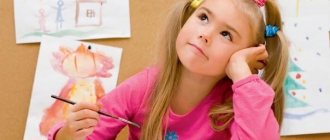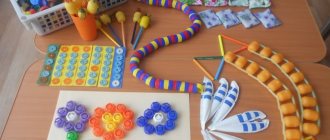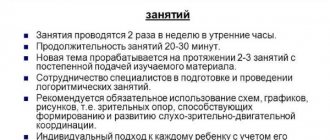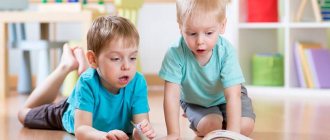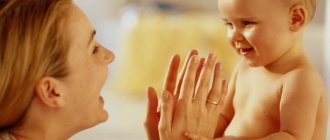Development of thinking in preschool children. How a person will grow up, what character qualities he will have, how active his thought process will be - is laid down in childhood. The preschool period is especially important. At this time, the body is undergoing intensive development, physical and mental, and the foundation of the individual is being laid.
Features of the development of thinking in a preschool child
Development of thinking in preschool children. During the preschool period, different types of thinking arise, and one becomes the basis for the emergence of another. The peculiarities of thinking depend on the acquired experience and knowledge that the child acquires on the path of growing up.
Thus, the prerequisites for thinking and understanding are laid from the very first months of life. The first rattle in a child’s life, the first actions with objects surrounding the baby - everything matters in establishing connections between a person and an object. Random actions can generate interest and attempts to repeat these actions again. For example, after hearing a rattle make sounds, your baby will shake it again to repeat the process.
In a small child, thinking cannot be conscious; it simply occurs as a consequence of the perception of reality. And only when the child begins to walk, gains motor activity, and thinking also actively develops. This stage begins when the child turns two years old. Moreover, initially thinking becomes a consequence of practical action. Without conscious brain function. Intelligence begins to develop when a child gets the opportunity to create something through games and educational, cognitive activities. As the child gains more and more knowledge, he learns to perform mental operations, and by the age of five he can analyze, compare, and generalize.
What is thinking?
There are many definitions of this concept, but, in essence, they all boil down to one thing: thinking is the process of cognition through generalizations, an indirect reflection of reality. That is, this is knowledge that we receive not from the senses, but through the thought process.
A simple example can be given: we look at a boiling kettle and know for sure that the water in it is very hot. We do not need to measure its temperature using special instruments, we do not need to test the water with our hands. We remember what boiling water looks like, and, having generalized our knowledge and extended it to a specific kettle of water, we draw a conclusion. This is how the thinking process works.
Let's look at the basic mental operations that help the cognitive process.
- Analysis is the mental operation of decomposing the object being studied into its component parts, properties or characteristics. Analysis helps to highlight certain properties of an object that we need in a particular case. There can be as many of them as you like. For example, how can you describe an apple? It is round, red, edible.
- Synthesis is an operation opposite to analysis, when objects or phenomena are combined into groups based on common features. In our example: something red, round and edible - what could it be? Apple? Yes, but not only - obviously, the description would include a tomato, a plum, and a candy of the appropriate shape.
- Generalization is the combination of various objects or phenomena into one group based on a common feature. For example: several items of different shapes - an apple, a banana and a pear - can be combined into the “Edible” group. And the apple, red bow and fire truck are in the “Red Objects” group.
- Comparison . Everything is simple here: objects or phenomena that have a common characteristic are compared with each other. The apple is as red as a fire truck, but much smaller. The common feature is color, the difference is size.
- Concretization . Based on general characteristics, specific objects can be identified. In our case: red objects - an apple, a fire truck, a bow. Edible products: banana, apple, pear, tomato.
- Analogy . Transferring knowledge about one subject/phenomenon to another (less studied or inaccessible for study). Knowing the characteristics of one apple, we can draw conclusions about all the apples in the basket.
Thinking operations also include:
- Abstraction is when, while studying a subject, it is necessary to concentrate on one of its properties, ignoring the rest. For example, a ball and an orange are round objects, and that’s where their similarities end. But if we need to name exactly objects that have the shape of a ball, we can abstract from the remaining properties of an orange and a ball.
- Classification is the distribution of objects according to some characteristics. For example, we can categorize objects by shape (round or not); color (red and not), the sign “edible or inedible”. Mental classification helps organize knowledge about a subject.
- Systematization - arrangement of objects in a certain order. For example, all red objects can be arranged according to size: fire truck - apple - bow.
The process of learning, acquiring any new knowledge, as a rule, includes a person simultaneously performing several such mental operations.
Types of thinking: stages of child development
Development of thinking in preschool children. The following types of thinking dominate in a preschooler:
- objective-active, which develops spurred by the child’s imagination; typical for children aged 1 to 2 years.
- visual-figurative, which develops on the basis of the child’s existing knowledge; typical for children aged 3 to 4 years.
- verbal-logical, since speech begins to play an important role in achieving any goal of the child; typical for children of older preschool age - 5-7 years.
Subject-effective thinking
The youngest preschoolers love to break toys. They are not aggressors releasing negative energy, they are explorers. The objects that surround the child are interesting to him, he wants to touch them and take them apart. One action follows another. Speech is not important here, and the little ones do not yet have the ability to speak and explain their actions. The child thinks with his hands, exploring the properties of each object.
Visual-figurative type of thinking
When a child turns three or four years old, he already owns certain images that he actively uses in play. At the same time, objective-active thinking occurs; visual-figurative thinking simply becomes its continuation.
Verbal and logical thinking
At the age of five, preschoolers are already actively chatting, can analyze information, and give a detailed answer. They use speech in play and in everyday life; children remember that with the help of speech it is easier to achieve the desired result.
Abstract-symbolic
With this thinking, the child can separate the essential properties, signs of an object from the unimportant. The baby understands that a specific object can be replaced by another if it has the same characteristic features.
Creative thinking (creativity)
Creativity knows no boundaries or age differences. Whether at two or six years old, a child can enthusiastically build castles with blocks, knead plasticine, or move a brush with paint over a sheet of paper. At the same time, the child makes or draws what he wants, showing imagination. The child also sings, plays music, and dances with his soul.
Perform developmental exercises from Ikyusha
Mathematics
Reading
The world
Logics
English language
Anagrams
Age: from 5-6 years
Anagrams are the rearrangement of letters in a word to form a new word. For example, sleep is nose, rakask is paint. Anagrams work well for children who can already read.
Such tasks increase concentration and speed of thinking, and also develop visual memory.
Schulte tables
Age: from 5 years
Many parents have heard about Schulte tables. These exercises are very popular as they increase concentration and develop memory in a light playful way. The child’s task is simple - to find in order the numbers or letters randomly located in the table. The sizes of the table vary depending on the age and preparation of the baby (usually from 3x3 to 16x16).
Exercise “Listen and count”
Age: 6-8 years
Another great exercise for focusing attention. You read the sentence while tapping your pencil or pen on the table. The child needs to remember both the text and the number of your strokes. If the baby begins to cope easily, complicate the task by gradually increasing the number of blows.
Exercises and games to develop thinking in preschool children
In order for thinking to actively develop, you need to constantly work with your child. To help parents and educators there will be didactic, educational and entertainment classes, excursions, meetings with specialists, as well as regular games with children.
Development of imaginative thinking in a preschooler
To develop imaginative thinking, games that involve “gray cells” are suitable. For example, an adult invites a child to look at a picture that shows various objects, but they can all be called in one word. These can be dishes, various animals, items of clothing, furniture, and transport.
Another good option is puzzles. To assemble a picture from many elements, you need to present it as a whole, pay attention to individual details, look for common features in the illustration in order to obtain the integrity of the image.
You can offer to play the game “Everything on the shelves”. In this game, from a bunch of completely different objects, you need to find only those that correspond to specific characteristics.
Development of logical thinking in preschool children
Both oral games and the use of visual materials will help to develop logical thinking.
Good oral games such as:
- "Let's make up a fairy tale"
In this game, the adult starts the story, and the child’s task is to finish it.
- "Yes and no"
A game with leading questions to which the second player answers: “Yes” or “No.” The task is to eventually guess the item conceived by the first player.
- "Association"
In this exercise you are asked to select words by association: Dress - summer, fur coat... (winter);
squirrel - hollow, bear... (den), etc.
Using visual materials:
- Make shapes from counting sticks.
- Play the “labyrinth” in the picture, helping the character along the path.
- Use the illustrations to create a story.
Development of creative thinking
Creative thinking is impossible without the child’s imagination and ability to operate with images. You can offer your child the following games and exercises:
- find familiar images in the blot,
- create an object from several different parts,
- find the same signs in different pictures,
- guess what an object is based on an oral description.
- draw using unconventional drawing.
Development of spatial thinking
In order for a child to navigate the world around him, he needs to develop spatial skills. Games suitable for this:
- with matches, when you need to build new ones from created figures,
- with drawings, when the child is invited, for example, to play a pirate and find a treasure, following the plan,
- exercise “Farther - Closer”, when the child is asked to move objects to close and far distances at the request of a parent or teacher,
- With your eyes closed, following the teacher’s instructions, you need to draw a line on a piece of paper.
